
About UsThe Numismatic Bibliomania Society is a non-profit organization promoting numismatic literature. For more information please see our web site at coinbooks.org SubscriptionsThose wishing to become new E-Sylum subscribers (or wishing to Unsubscribe) can go to the following web page link MembershipThere is a membership application available on the web site Membership Application To join, print the application and return it with your check to the address printed on the application. Membership is only $15 to addresses in the U.S., $20 for First Class mail, and $25 elsewhere. For those without web access, write to: David M. Sundman, Secretary/TreasurerNumismatic Bibliomania
Society AsylumFor Asylum mailing address changes and other membership questions, contact David at this email address: dsundman@LittletonCoin.com SubmissionsTo submit items for publication in The E-Sylum, just Reply to this message, or write to the Editor at this address: whomren@coinlibrary.com
BUY THE BOOK BEFORE THE COINYou won't regret it! |
- WAYNE'S WORDS: THE E-SYLUM SEPTEMBER 26, 2010
- THE ASYLUM: THE SECOND UNITED STATES MINT AND THE CASKET
- LAKE BOOKS 104TH MAIL-BID SALE CLOSES SEPTEMBER 28, 2010
- SPINK TO SELL RARE 1852 ORMSBY WORK SEPTEMBER 29, 2010
- DIX NOONAN WEB TO OFFER GRIFFITHS BRITISH TRADE TOKEN BOOKS OCTOBER 6, 2010
- SKLOW NUMISMATIC LITERATURE SALE 11 CLOSES OCTOBER 9, 2010
- OCTOBER 30, 2010 DAVIS SALE CATALOG AND LOT IMAGES AVAILABLE
- NEW BOOK: WORLD PAPER MONEY, GENERAL ISSUES, 1368-1960, 13TH EDITION
- NEW BOOK: CASTORLAND JOURNAL
- NEW BOOK: THE PRINCE EDWARD ISLAND HOLEY DOLLAR
- NUMISMATIC AUTHORS' LIBRARIES DISPERSED
- ANS MAGAZINE SUMMER 2010 ISSUE
- THE CONDER TOKEN COLLECTOR'S JOURNAL FALL 2010
- JOHN AND NANCY WILSON ON THE SCHINGOETHE SALE CATALOGS
- MORE ON MEDAL AWARDED TO CARPATHIA CREW FOR TITANIC RESCUE
- QUERY: IMAGES OF MODERN GREEK PATTERN COINS SOUGHT
- QUIZ ANSWER: U.S. COINS PICTURING WATERCRAFT
- TO PRICE OR NOT TO PRICE? THAT IS THE QUESTION
- THE MYSTERY OF B. MAX MEHL'S COST CODE
- ROBERT E. MATTHEWS: NUMISMATIST AND PHARMACIST
- NUMISMATIC GOSSIP: MANLEY HOME, NEW YORK SHOWDOWN
- THE ANTHONY TERRANOVA COLLECTION OF COUNTERSTAMPED COINS
- MORE ON UNIVERSITY DEGREES IN NUMISMATICS
- NOTES FROM E-SYLUM READERS: SEPTEMBER 26, 2010
- INDIAN BANKNOTE COLLECTOR TO OPEN MUSEUM, PUBLISH BOOKS
- WILL RUSSIA ABOLISH ONE AND FIVE KOPEK COINS?
- ALTERNATE USE FOR SILVER COINS: KILLING BACTERIA
- WEEKLY WORLD NEWS BREAKS STORY: OBAMA ON NEW DOLLAR BILL
- FEATURED WEB SITE: PORTABLE ANTIQUITIES SCHEME DATABASE
WAYNE'S WORDS: THE E-SYLUM SEPTEMBER 26, 2010

Among our new subscribers this week is Win Callender of Heritage. Welcome aboard! We now have 1,371 subscribers.
This week we open with an excerpt from the latest issue of our print publication, The Asylum. Next, we have updates on FIVE upcoming sales of numismatic literature and announcements of three new books.
Next up are excerpts and mini-reviews of recent numismatic periodicals including ANS Magazine and the Conder Token Collector's Journal. Other topics this week include the Schingoethe obsolete paper money sale catalogs, breaking B. Max Mehl's cost code, counterstamped coins, and Indian paper money.
To learn about Edger Allan Poe's Casket, Castorland jetons, Timothy Antiquary, Dr. Timbercracks, and High Noon on 57th Street, read on. Have a great week, everyone!
Wayne Homren
Numismatic Bibliomania Society
THE ASYLUM: THE SECOND UNITED STATES MINT AND THE CASKET
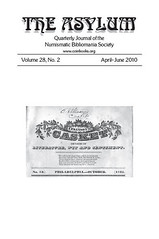 My issue of our print publication, The Asylum arrived this week.
Remember, while The E-Sylum is free to all, only paid members of the Numismatic Bibliomania Society receive The Asylum. Here's a teaser of what non-members are missing out on. Below is an illustration and the opening paragraph from Joel Orosz' cover article, The Second United States Mint and The Casket. Thanks, Joel - great article.
-Editor
My issue of our print publication, The Asylum arrived this week.
Remember, while The E-Sylum is free to all, only paid members of the Numismatic Bibliomania Society receive The Asylum. Here's a teaser of what non-members are missing out on. Below is an illustration and the opening paragraph from Joel Orosz' cover article, The Second United States Mint and The Casket. Thanks, Joel - great article.
-Editor
It is a tale strange to relate, for it recounts how the American public's first look at the second Mint of the United States was observed through a casket—or, more precisely—through The Casket, a now-defunct magazine in Philadelphia. If this isn't peculiar, or perhaps unsettling, enough, The Casket in question was also intimately connected to Edgar Allan Poe. The cast of characters only expands from there, for Benjamin Franklin, William Shakespeare, Emmanuel Joseph Attinelli, plus an early auction sale of medals, and the very first detective story ever published, all play bit roles in this drama most improbable. Never fear, though, for just as in any of the Bard of Avon's productions, the strange and wonderful cast of characters will all be reconciled by the time the final curtain falls.
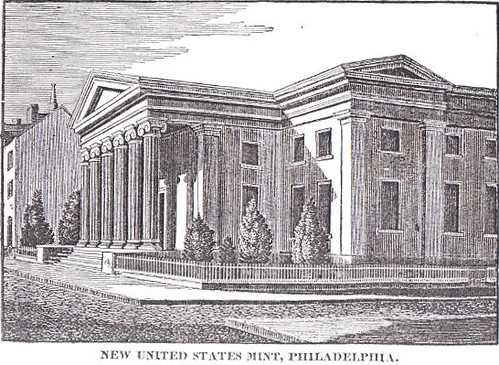
To read the earlier E-Sylum article, see: THE ASYLUM VOLUME 28, NUMBER 2 PUBLISHED (www.coinbooks.org/esylum_v13n36a02.html)
LAKE BOOKS 104TH MAIL-BID SALE CLOSES SEPTEMBER 28, 2010
 This is a reminder that Lake Books' 104th mail-bid sale of numismatic literature closes on Tuesday, September 28, 2010 at 5:00 PM (EDT). The 514-lot sale features selections from the library of Col. Bill Murray and you may view the sale at http://www.lakebooks.com/current.html
This is a reminder that Lake Books' 104th mail-bid sale of numismatic literature closes on Tuesday, September 28, 2010 at 5:00 PM (EDT). The 514-lot sale features selections from the library of Col. Bill Murray and you may view the sale at http://www.lakebooks.com/current.html
Your bids may be placed via email, fax or telephone until the closing time. Good luck with your bidding.
Lake Books
6822 22nd Ave. N.
St. Petersburg, FL 33710
727-343-8055 Fax 727-345-3750
To visit the firm's web site, see: www.lakebooks.com
SPINK TO SELL RARE 1852 ORMSBY WORK SEPTEMBER 29, 2010

W.L.Ormsby, a book bound in green leather with gold lettering and titled 'A description of the present system of Banknote engraving', printed New York, 1852, cotaining various plates and engravings including a sheet of Railroad Bank $1 (4), Adrian, multiple vignettes and engine turnings excellent condition, attractive and rare Estimate £ 500-700
To read the complete lot description, see:
Sale 1022 Lot 1730
(www.spink.com/asp/fullCatalogue.asp?
salelot=1022++++1730+&refno=11572347)
DIX NOONAN WEB TO OFFER GRIFFITHS BRITISH TRADE TOKEN BOOKS OCTOBER 6, 2010
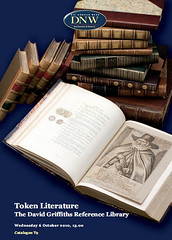 David Griffiths was born in Conway, North Wales, in
1940, moving to London when he was five. Like
many expatriates, he became very keen in
retaining his links with his mother country, and in
addition to representing it at athletics in sprint
events, he realised how interesting it was to link
local history with collecting.
David Griffiths was born in Conway, North Wales, in
1940, moving to London when he was five. Like
many expatriates, he became very keen in
retaining his links with his mother country, and in
addition to representing it at athletics in sprint
events, he realised how interesting it was to link
local history with collecting.
Initially he collected Welsh 17th century tokens, triggered by the 1973 publication of George Boon's book on the subject. But, finding out how much individual 17th century tokens cost and, encouraged by Monica Bussell (1906- 74) at Seaby's, David decided to start collecting Welsh 18th century tokens, principally Anglesey. He now has the largest collection of these pieces ever assembled.
David has expanded his 17th century token interests to cover Hertfordshire, of which county his collection is now the largest of its kind ever formed, and other counties, in particular Middlesex, Bedfordshire, Berkshire, Buckinghamshire, Hampshire, Lincolnshire, Rutland, and Shropshire. His collection of 18th century tokens covers all counties, with a particularly large group of Middlesex tokens, and his smaller 19th century collection includes tickets, checks and medals.
A regular at the annual British Token Congress for many years, David single-handedly ran the 1998 event at Hemel Hempstead and was a co-organiser of the Congress when it visited Warwick in 2008.
Having an interest in antiquarian books David extended this to books on tokens, which are the subject of today's sale. He has gradually built up a definitive collection for all token series, as the linking of tokens and books is essential if the enjoyment of a token collection is to be maximised.
This auction is the most important of its kind ever to have taken place. A keen buyer of token books for over 30 years, David has never missed an opportunity to acquire a significant volume, whether it be from an antiquarian or numismatic book dealer, or in the cut and thrust of auction room competition. The provenances of some of the lots in this sale extend back to the libraries of doyens of the subject like Williamson, Davis, Hamer, Dalton, Waters, and others. Here you will find such desiderata as two copies of Thomas Sharp's catalogue of the Chetwynd collection, pioneering catalogues of 18th century tokens by Hammond and Williams, an original R.T. Samuel ‘Bazaar Notes', and much else besides.
Having now reached a level of completion with the books, David has decided to part with them. His token collection will be the subject of further auctions in these rooms over the next two to three years.
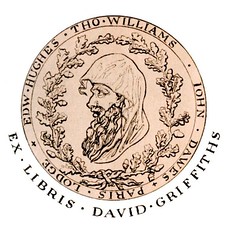
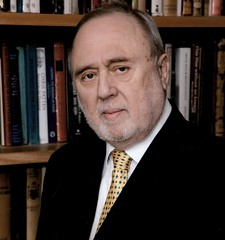
For more information, see the DNW web site at: www.dnw.co.uk
SKLOW NUMISMATIC LITERATURE SALE 11 CLOSES OCTOBER 9, 2010
A gentle reminder Numismatic Literature Mail Bid Sale # 11 closes Saturday October 9 @ PM MT.
You may submit bids via Telephone, Fax, U.S. Mail and Email. If you have already submitted bids please consider this another thank you! Be sure to check our web site for highlights of future sales.
David Sklow-Fine Numismatic Books
P.O. Box 6321
Colorado Springs, CO 80934
PH: 719-302-5686
FAX: 719-302-4933
EMAIL: numismaticbooks@aol.com
WEB:
FineNumismaticBooks.com
OCTOBER 30, 2010 DAVIS SALE CATALOG AND LOT IMAGES AVAILABLE
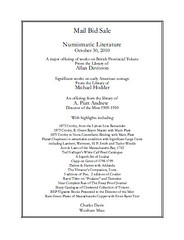 Charles Davis's October 30 Mail Bid Sale of Numismatic Literature is now posted on his website at
www.charlesdavisnumismatics.com/numis_images/Oct30sale.pdf
.
Charles Davis's October 30 Mail Bid Sale of Numismatic Literature is now posted on his website at
www.charlesdavisnumismatics.com/numis_images/Oct30sale.pdf
.
In addition, some 200 photographs of lots are posted there as well with more being added daily.
Charles Davis
Numismatic Literature
P.O. Box 547
Wenham, MA 01984
Tel: (978) 468 2933
Fax: (978) 468 7893
www.vcoins.com/ancient/charlesdavis
To read the earlier E-Sylum article, see: DAVIS SALE OF DAVISSON AND HODDER MATERIAL CLOSES OCTOBER 30, 2010 (www.coinbooks.org/esylum_v13n38a04.html)
THE BOOK BAZARRE
NEW BOOK: WORLD PAPER MONEY, GENERAL ISSUES, 1368-1960, 13TH EDITION
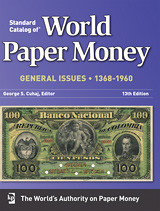 Krause Publications has released a new edition of the Standard Catalog of World Paper Money, General Issues, 1368-1960.
Krause Publications has released a new edition of the Standard Catalog of World Paper Money, General Issues, 1368-1960.
Now in its 13th edition, this mammoth resource features bank notes from more than 230 note-issuing authorities. Key features of the book include:
-25,100 bank note varieties with current values in three condition grades. -Enhanced note and color descriptions, allowing users to quickly identify varieties. -More than 8,000 quality photographs to assist with identification. -Historical details, grading definitions and numeral charts.
Organized by international bank note expert George S. Cuhaj, with valuable input from more than 80 experts worldwide, this one-stop reference provides users with everything they need for identifying and valuing world bank notes and staying up to date in today's market.
Editor George S. Cuhaj is a 16-year veteran of Krause Publications' Numismatic Catalog Division, where he is also the editor of the Standard Catalog of World Coins series. Cuhaj hails from New York City, where he was previously on staff with the American Numismatic Society, Stack's Rare Coins and R.M. Smythe & Co. He is a frequent instructor at the American Numismatic Association's Summer Seminars.
For more information, or to order, see:
www.shopnumismaster.com/product/standard-catalog
-of-world-paper-money-general-13th-edition/world-paper-money.
NEW BOOK: CASTORLAND JOURNAL
Anne E. Bentley of the Massachusetts Historical Society writes:
In his most recent blog entry, Jeremy Dibbell, one of our reference librarians, has noted a recent publication on the Castorland Journal (the original manuscript journal is in our collection) which might be of interest to your readers who collect Castorland jetons.

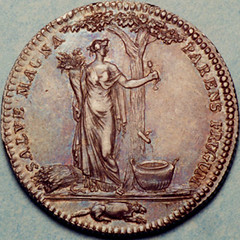
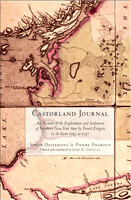 Another of the new publications featuring an MHS collection is Castorland Journal: An Account of the Exploration and Settlement of Northern New York State by French Émigrés in the Years 1793 to 1797, by Simon Desjardins and Pierre Pharoux. This edition, just published by Cornell University Press, was edited by John A Gallucci, Assistant Professor of French at Colgate University, and contains a very useful introduction, footnotes, and appendices.
Another of the new publications featuring an MHS collection is Castorland Journal: An Account of the Exploration and Settlement of Northern New York State by French Émigrés in the Years 1793 to 1797, by Simon Desjardins and Pierre Pharoux. This edition, just published by Cornell University Press, was edited by John A Gallucci, Assistant Professor of French at Colgate University, and contains a very useful introduction, footnotes, and appendices.
Desjardins and Pharoux were agents of the French Compagnie de New York, sent to manage the company's Castorland tract in what are today Lewis and Jefferson Counties. The journal recounts their travels, business meetings (with the likes of Philip Schuyler, Thomas Jefferson, Alexander Hamilton, and Aaron Burr) and the many obstacles they faced.
The original Castorland journal was given to the Historical Society in September 1863 by William Appleton, after having been found and purchased in a Paris bookstall.
To read the complete blog entry, see: New on our Bookshelves (www.masshist.org/blog/378)
For more information on the book, or to order, see: CASTORLAND JOURNAL (www.cornellpress.cornell.edu/cup_detail.taf?ti_id=5638)
NEW BOOK: THE PRINCE EDWARD ISLAND HOLEY DOLLAR
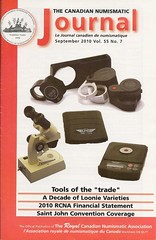 According to an article in the September 2010 issue of The Canadian Numismatic Journal, the board of the J. Douglas Ferguson Historical Research Foundation
According to an article in the September 2010 issue of The Canadian Numismatic Journal, the board of the J. Douglas Ferguson Historical Research Foundation
approved funding for the Prince Edward Island Holey Dollar book by Chris Faulkner. This monumental work will be published in 2011.
For more information on the J. Douglas Ferguson Historical Research Foundation, see:
www.nunet.ca/jdfhrf.htm
NUMISMATIC AUTHORS' LIBRARIES DISPERSED
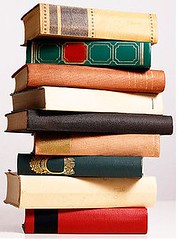 I note with interest Dave Bowers has purged his library of a large number of books on sunken treasure and other treasure trove. Lucky for the rest of us to now have the opportunity to acquire these book treasurers ourselves.
I note with interest Dave Bowers has purged his library of a large number of books on sunken treasure and other treasure trove. Lucky for the rest of us to now have the opportunity to acquire these book treasurers ourselves.
But it does bring up the question: When should an author dispose of part or all of his library? I like Dave's solution. Apparently he no longer needs these books to write on the subject in the future. Can we believe he has extracted all the meat he needs from these volumes? Has he squeezed all the juice from these literary tidbits?
I have done the same by consigning small groups to the numismatic auction block in the past (more for a need of shelf space than anything else). The largest group was to Harmar Rooke (circa 1970) as a favor to Don Taxay who had recently been hired by the New York firm. I realized I must downsize when I had five Crosby's and forty-some-odd Evans'. (I had attempted to amass a "roll" of fifty Evans' and I almost made it!)
This week I read an article which addressed this same problem - it was mentioned by John Lupia in last week's E-Sylum. The problem seems universal for writers. From the fact Ernest Hemingway's 9,000 volume library is still impounded intact in his Cuban villa, to a fiction writer, David Markson, who insisted his library be disseminated by the Strand bookstore. (Lucky him, he lived only a few blocks from the Strand and visited it two or three times a week. I wish I could do that in a year!)
It's a lengthy article, but highly enjoyable, as each of must face the mortality of our own book collection.
To read the original Boston Globe article, see:
Lost libraries: The strange afterlife of authors' book collections
(http://www.boston.com/bostonglobe/ideas/articles/2010/09/19
/lost_libraries/?page=full)
To read the earlier E-Sylum article, see: LOST LIBRARIES: THE STRANGE AFTERLIFE OF AUTHORS' BOOK COLLECTIONS (www.coinbooks.org/esylum_v13n38a16.html)
ANS MAGAZINE SUMMER 2010 ISSUE
My copy of the Summer 2010 issue of ANS Magazine from the American Numismatic Society arrived this week. As usual, the issue is chock-full with wonderful images and stories about numismatic items. For bibliophiles there's an article by Andrew Meadows on "Systematic Recording of Greek Coin Hoards and the ANS" (p38) which describes the many ANS publications on this important topic, beginning with Numismatic Notes and Monographs number 1 by Sidney Noe, "Coin Hoards".
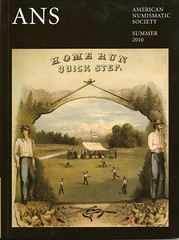 Noe's preliminary thoughts on the subject were followed just five years later with a more practical aid to the study of hoard material. A Bibliography of Greek Coin Hoards, Numismatic Notes and Monographs 25, changed the face of the study of ancient Greek coinage by introducing a systematic attempt to record all the relevant hoard material in one place.
Noe's preliminary thoughts on the subject were followed just five years later with a more practical aid to the study of hoard material. A Bibliography of Greek Coin Hoards, Numismatic Notes and Monographs 25, changed the face of the study of ancient Greek coinage by introducing a systematic attempt to record all the relevant hoard material in one place.
Collections Manager Elena Stolyarik presents a well-illustrated 13-page article (p43) on recent acquisitions running the gamut from ancient Greek coins to counterfeits, coin scales, and modern coins of Uzbekistan and the United States. The donors are to be commended - they include Tony Terranova, Ute Wartenberg-Kagin, David Gladfelter and David Menchell. The Society made a number of purchases as well, including medals of the National Academy of Sciences and the American Geographical Society.
The cover article by Oliver Hoover is "Baseball as Civilization: Indian Peace Medals Under James Buchanan and Abraham Lincoln" (p56). The article discusses the scenes of children playing ballgames on the medals and is illustrated with several early images of versions of the national pastime.
Ute Wartenberg Kagan's article "Funny Money" (p14) is a companion to the Society's current exhibit on counterfeiting in the U.S., discussed in an earlier E-Sylum issue.
Robert Hoge's article on "Current Cabinet Activities" (p26) discusses an upcoming exhibit of which the ANS is one of many donor institutions. "War and Peace: Masterpieces of Patriotic Jewelry and Decorations" is planned to be displayed aboard the aircraft carrier USS Intrepid.
This extraordinary presentation ... was organized by the National Jewelry Institute and will include a selection of medallic pieces. Following its New York debut, War and Peace will relocate to the Pentagon in Washington, D.C.
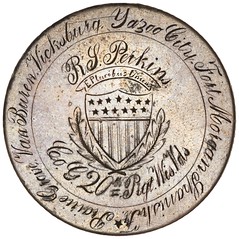
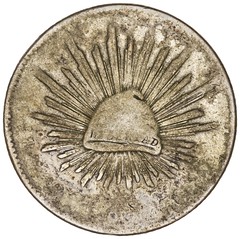
20th Wisconsin Volunteers "Peso" medal (ANS collection)
Hoge kindly provided some images for The E-Sylum. Thanks! The exhibit was supposed to open on Veteran's Day, but there's been a snag. He writes:
Please note, however, that this entire exciting exhibit, scheduled to be shown on board the Intrepid and at the Pentagon, has been postponed!! We were so informed, unfortunately, after the ANS Magazine had already gone to press. I do not know if the new opening dates have been established as yet, but I think everything has been set back by perhaps one year. I don't know whose decision this was, or whether it was a financial, logistical or security matter. But I do know that all the wonderful loan items had already been "lined up," and the borrowers' fees paid. Meanwhile, some of our included specimens are so desirable and popular that we are considering honoring other loan requests during the interval.
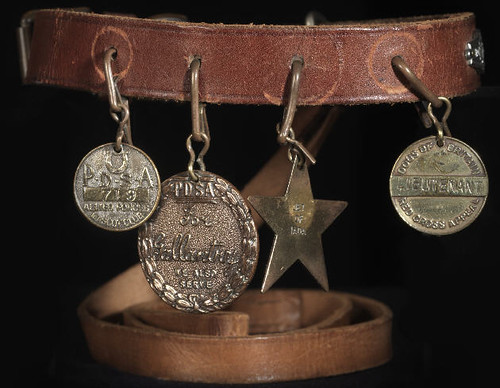
Dog collar and lead, with Dickin Medal. Awarded to Rex the Dog in 1945.
Courtesy Imperial War Museum
(First printed in ANS Magazine, Summer 2010 issue. "Library News: Counterfeiting and Fraud Features in Rare Book Room Acquisitions."):
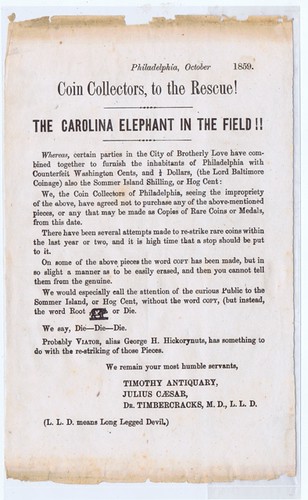
One interesting item acquired was a broadside (Figure) previously in the collection of J.N.T. Levick and discovered in the specially-printed personal copy of his famous 1865 coin sale (see lot 99 of the Kolbe sale). Measuring 24.5 x 15 cm and dated to October 1859, this broadside decries the counterfeiting of various early American pieces at that time.
As Kolbe best summarizes on p. 24 of his thorough catalog of the Stack Family Library sale, the signatories of this broadside may include members of the “eight founders of The Numismatic Society of Philadelphia, established December 28, 1857 and renamed The Numismatic and Antiquarian Society of Philadelphia in 1865…
Timothy Antiquary may be Edward Cogan, the principal Philadelphia coin dealer of the day and Dr. Timbercracks may be Mark W. Collet, a medical doctor who was intimately involved in the hotbed of numismatic activity then taking place in Philadelphia.
The villains in the piece were probably William Idler and Montroville Wilson Dickeson, both known to have made reproductions of the items noted. Viator, alias George H. Hickorynuts likely refers to Dickeson. In the 1850s, he toured the Country excavating Indian burial mounds and conducting illustrated lectures on the topic (Viator = a traveler; wayfarer).”
The broadside is extremely rare and in fine condition and makes an excellent addition to the Library collections.
The broadside appeared during a noteworthy year in the history of numismatics: 1859. It was the year after the formation of the ANS, the year before the outbreak of the American Civil War, and a formative year for numismatic auction catalogs, in large part due to one of the characters mentioned above, Edward Cogan. Described as “a gentleman of great conversational powers and amiable temper, besides being well-supplied with anecdotes and jokes” (AJN Nov. 1867), Cogan is easy to associate with the light humor and yet concern for the coin trade behind this broadside.
The year 1859 was also the year when the first comprehensive encyclopedia of American coins was issued. The book was written by one of the two villains mentioned in the broadside, Montroville Wilson Dickeson. William Idler was another coin dealer active in Philadelphia (where he settled in 1859) known to have created and sold restrikes, notably copies of the 1792 Washington half dollar. The Sommer Islands (now Bermuda) referenced in the broadside were also called the Hog Islands (or Hogge Islands)
The humorous undertone of the broadside is best seen in its call to replace the word “copy” with the word “Root, [Hog], or Die.” This expression was a common American phrase from the 19th century and an idiomatic expression for self-reliance. It comes from the early colonial practice of turning pigs loose in the woods to survive on their own.
THE CONDER TOKEN COLLECTOR'S JOURNAL FALL 2010
 "A Curmudgeon's Copy of Conder's Arrangement"
"A Curmudgeon's Copy of Conder's Arrangement"
A couple of years ago, I went to England to do research for The Virtuoso's Arrangement, my book on the classic literature of the British tokens of the 18th and 19th centuries. One of the outstanding collections of token literature is held by the Guildhall Library in London. While there I ran across a most interesting (and amusing) copy of Conder's An Arrangement of Provincial coins, Tokens and Medals. Unfortunately, the volume is not signed by the original owner, but there are some clues that might allow the owner to be unmasked. As you will see, David Dykes makes a strong case that the original owner was Samuel Birchall. But what do you think? I would love to hear from you.
1798 edition. Interleaved, in two volumes. Bound in brown quarter leather with raised bands, gilt titles and maroon cloth boards. The binding is quite old. The original owner, apparently a contemporary to Conder and a somewhat contrary fellow has copiously annotated the volumes with neat additions and commentary, but, alas, no bookplate or ownership inscriptions. There is the ink signature of a later owner, “J. H. Burn July 1846” clearly in a different hand. The original owner leaves a clue as to his identity in that he has bound in “An exact List of the Number of my Private Token, with the manner of their disposal.”

The record of distribution isn't listed past the twentieth piece, but the numbering extends to at least #26, so we know something of the mintage of the private token. We also know that he is not W. Millar, M. Young, Hancock, Mr. Sharpe, Mr. Pye, Mr. Western, Mr. Humphry, Mr. Skidmore, Mr.Chater, Miss Banks or poor Mr. Welch whom our mystery man labels, “a mere fraud”. As the Thomas Welch tokens are my favorite and I have, for no other reason than it pleases me, decided that he is my direct ancestor, this really hurts! Though it is marked over, the first piece seems to say “Bronzed Unique”.
Also bound in is a closely written four-page review of Conder's work. Our cranky correspondent initially allows, “This, certainly is by far the most compleat publication of the kind published,” but continues, “in some points, I must confefs, I differ from Mr. Conder. In the first place, in arranging the Coins by Edge; which certainly is far from a good plan . . .”
After providing several examples of Conder's folly he really begins to warm to his subject, “In the next place, when describing a coin of the same device with a few exceptions to the one preceding it, he (Conder) says, “The same as last differently executed.” What guide can this be to a person in collecting without the difference stated? It would have been better to have omitted it altogether, than to give it in so imperfect a manner.”
“Thirdly, I very much differ from him in arranging the pieces according to the Reverse, which certainly is as injudicious as by the edge . . .” Now he takes off the gloves, “. . . repetitions similar to this occur in other instances, merely on the excuse that the imprefsions are on thicker Copper & profefs on the edge to be Penny Tokens . . . Their fabrication is peculiarly contemptible & they are entirely independent of the principles of the Provincial Halfpence. What excuse Mr. C. can find for this insertion, I am at a loss to conjecture, but this I know, if they are arranged with the rest of the Provincials, a disgrace is instantly stamped on the cabinet.”
The invective continues, but you get the idea. Written in the margin on the page that Conder lists the tokens of Thomas Spence is the underlined notation, “The execution of these is so vile, that the mention of them is a disgrace to this work.” The annotator is clearly a knowledgeable numismatist and many of his criticisms, while harsh, are justified. Throughout he has neatly expanded upon Conder's “Arrangement”, cataloging many pieces either not noticed by Mr. Conder or struck subsequent to the publication of his work.
At the end of his article Harold notes: "I am planning to make a trip this fall to complete my research on the British token literature. I have included a request in the journal's free ads for some time requesting members who own pre-World War II token literature to contact me so that I might include their volumes in my listings. If you haven't noticed the ad or just haven't gotten around to contacting me, PLEASE DO. This work has been drawn out for much too long, but after my trip to England, I hope to put on a big push and finally wrap it up. I really want to be as complete as possible, but I need your help!
Harold Welch
tokenmann@aol.com"
Please lend a hand to this great project, folks! Can you help?
-Editor
JOHN AND NANCY WILSON ON THE SCHINGOETHE SALE CATALOGS
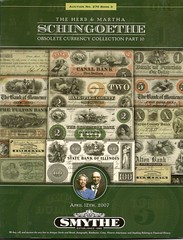
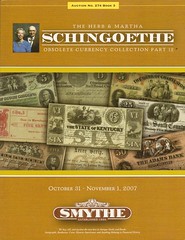
We applaud the author (Len Augsburger) and everyone who contributed to the "100 Greatest Items of American Numismatic Literature." We are sorry that we couldn't have contributed more for this worthwhile project. We have several of the top 100 that are listed in our own library. It was sad that the catalogs from Smythe (later Spink / Smythe), containing the collection(s) of Herb and Martha Schingoethe were not included in the survey. If you collect obsolete notes, other numismatic paper money or ephemera items you will need these sales catalogs.
Herb and Martha Schingoethe were two of the greatest collectors of obsolete paper money, depression scrip, college currency, checks and other items that ever lived. We were very good friends of Herb and Martha and even bid against them in some of the sales we both attended. The first sale was held on October 22-23, 2004 and the last, Part 18 on June 25, 2009. The firm also had some other related sales containing selected items that were added to the 18, or just separate sales.
We are glad the Haxby four volume set is included in the top 100. If you collect obsolete U. S. obsolete notes you will need that four volume set, along with the very important Christie's sale of Important Early American Bank Notes (archives of ABNCo), 1810-1874 held on 9/14-15/1990 and the Spink America sale of Important Early American Paper Money (the collection of the Western Reserve Historical Society) held on 11/25-26/1996. If you have the four volume Haxbys, Christie's ABNCo sale, and Spink Western Reserve Sale catalogs you are pretty complete with most information you will need on collecting U. S. obsolete notes. However, without the Smythe / Spink-Smythe Schingoethe sales you will be lacking many thousands of notes that are not in the aforementioned four volume Haxby and two other sales.
Trying to get the 18 Schingoethe sales catalogs (and related sales) today would be very hard.
To read the earlier E-Sylum article, see: NBS U.S. NUMISMATIC BIBLIOGRAPHY PROJECT UPDATE (www.coinbooks.org/esylum_v13n38a02.html)
MORE ON MEDAL AWARDED TO CARPATHIA CREW FOR TITANIC RESCUE
Thanks! Below is the bronze specimen mentioned last week. -Editor
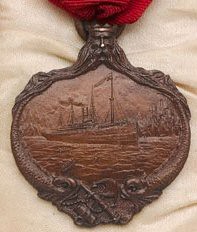
SPECTACULAR GOLD TITANIC AWARD MEDAL, 1912. 39.2 x 35mm kidney shaped. 15.0 grams 14k Gold. Very Fine. The obverse depicts the Carpathia coming to the aid of the Titanic's lifeboats in an ice field. Raised border depicting the crowned head of Neptune above, dolphins at the sides and an anchor and hailing trumpet motif below. An engraved inscription on the reverse reads as follows: PRESENTED TO/ MR. E. HY. HUGHES/ R.M.S. CARPATHIA/ BY THE/ RESCUED "SURVIVORS OF THE ILLFATED "TITANIC" ' LOST/ 14 APRIL/1912.. Stamped 14k mark at bottom. The medal has been polished and an earlier mount removed from the back (without disturbing the inscription.)
EVAN HENRY HUGHES, Chief Steward of the Cunard steamer Carpathia is one of six individuals recorded as recipients of gold medals at the special ceremony held in New York on May 29th, 1912. Reportedly these medals were actually presented by Mrs. Margaret Brown (the "Unsinkable" Molly Brown), who had famously seized the tiller of lifeboat #6 to turn it around in order to pluck survivors from the freezing ocean.
The other known examples of the Titanic/ Carpathia medal (in both gold and bronze) are unnamed and bear a die struck reverse inscription that reads, PRESENTED/ TO/ THE CAPTAIN/ OFFICERS & CREW/ OF/ R.M.S. "CARPATHIA"/ IN RECOGNITION OF GALLANT &/ HEROIC SERVICES/ FROM THE SURVIVORS/ OF THE/ S.S. "TITANIC"/ APRIL 15TH `9`1/ DIEGES & CLUST/ N.Y. (14KT impressed above the maker's name.)
This medal first appeared at auction in Sotheby's London Sale of July 7, 1998, Lot #99, where it brought 8050 pounds including buyer's fee. The Sotheby cataloger stated that it was "a piece of uncertain status lacking the usual reverse inscription in relief and therefore possibly a cast copy, with traces of removal of a broach-mount from the reverse and has been polished, about very fine." He further opined that it "….seems likely that the present piece was prepared subsequently for Mr. Hughes, perhaps as a private order. Its well-worn and re-mounted condition presents some difficulty and it may be noted that although the dimensions are exactly as other examples, the weight, at 14.97 grams is some 1.5 grams lighter than the gold medal awarded to Fifth officer Gustav J. Rath (Sold by Sotheby's New York, 29 July 1997, Lot 492." )
The suggestion that this is a replacement issue made from a casting of an original gold medal is erroneous. The dimensions of this piece are identical to that of the Rath Medal. Had this been a cast from an original, there would have been some measurable shrinkage from the original size. The fact that this medal weighs some 1.5 grams less than the Rath medal can be accounted for, if, as we believe, Mr. Hughes had the back of his original gold medal planed down and a customized inscription engraved on it.
We are joined in this opinion by Michael Hodder of Stacks who reached the same conclusion when he cataloged this medal for its appearance in Stack's Action Sale of March, 2001, lot #949.
EBay 1/04. Bronze. Unc. In original Dieges & Clust Box. $5433.00. ,
EBay 5/02 $8500.00
To read the earlier E-Sylum article, see: BONHAMS'S TO SELL MEDAL AWARDED TO CARPATHIA CREW FOR TITANIC RESCUE (www.coinbooks.org/esylum_v13n38a22.html)
QUERY: IMAGES OF MODERN GREEK PATTERN COINS SOUGHT
Is there a book with pictures of modern Greek pattern coins? If such exists, can I borrow it from somewhere for a few days?
My 1986 copy of the Standard Catalog of World Coins includes pictures of Greek patterns but the 2010 edition does not. The ANA library suggested "Greco Catalogue of Modern Greek and Cretan Coinage" but it is apparently as old as my 1986 SCWC.
I have seen and filed some Greek patterns listed in auction catalogs. Greek patterns are very expensive and I doubt if I can afford them, but I would like to include them in my lists of "Wildmen of the World".
QUIZ ANSWER: U.S. COINS PICTURING WATERCRAFT
In last week's review of Yossi Dotan's new volume about Watercraft on World Coins, I wrote:
QUICK QUIZ: which coins in the U.S. Statehood Quarter Dollar series picture watercraft? They are all listed and pictured here. How many other U.S. coins (including commemoratives) picture watercraft? This chapter of the book would make a great guide for building an interesting collection and exhibit of U.S. coins.
Author Yossi Dotan writes:
Your quick quiz "Which coins in the U.S. Statehood Quarter Dollar series picture watercraft?" is even better than you imagined: E-Sylum readers who rely on my book to find the answer, will get it WRONG. (Only after publication of the book I found out that there is one more quarter in the series that depicts watercraft). The correct number, including the one I missed, is 8.
Pete Smith writes:
The most recent Red Book that I have at home is from 2005 so I don't have a good source for the modern stuff. The following is what I found:
Statehood Quarters: New Jersey, Virginia, Rhode Island, Maine, Missouri, Florida, Minnesota.
Territories Quarters: Guam, Northern Mariana Islands.
Old Commemoratives: Bay Bridge, Columbian Exposition, Delaware, Hudson - New York, Huguenot, Long Island, Norfolk, Pilgrim, Providence - R.I., Roanoak Island, San Diego - California - Pacific (easy to miss).
Modern Commemoratives: Korean War 1991, Columbus Half 1992, Columbus Dollar 1992, Leif Ericsson 2000.
As to the Amer*** the Beau***** quarters, copyright laws prevent me from describing them.
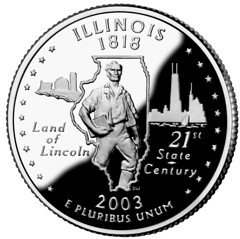

Statehood Quarters – copper-nickel clad copper, issued also in .900 silver
1. 25 cents 1999 New Jersey KM-292
2. 25 cents 2000 Virginia KM-310
3. 25 cents 2001 Rhode Island KM-321
4. 25 cents 2003 Maine KM-341
5. 25 cents 2003 Missouri KM-342
6. 25 cents 2003 Illinois KM-343
7. 25 cents 2004 Florida KM-356
8. 25 cents 2005 Minnesota KM-371
Other commemoratives:
9. ½ dollar 1892-93 .900 silver Columbian Exposition KM-117
10. ½ dollar dual date 1620-1920 .900 silver, issued also in 1921 Pilgrim Tercentenary KM-147
11. ½ dollar dual date 1624-1924 .900 silver Huguenot–Walloon Tercentenary KM-154
12. ½ dollar 1935 .900 silver Hudson, New York Sesquicentennial KM-170
13. ½ dollar 1935-36 .900 silver San Diego, California Pacific Exposition KM-171
14. ½ dollar 1936 .900 silver Bay Bridge San Francisco–Oakland KM-174
15. ½ dollar 1936 .900 silver Delaware Tercentenary KM-179
16. ½ dollar 1936 .900 silver Long Island Tercentenary KM-182
17. ½ dollar 1936 .900 silver Norfolk, Virginia Bicentennial KM-184
18. ½ dollar dual date 1636-1936 .900 silver Providence, Rhode Island Tercentenary KM-185
19. ½ dollar 1937 .900 silver Roanoke Island, North Carolina KM-186
20. ½ dollar 1986 copper-nickel clad copper Statue of Liberty KM-212
21. 1 dollar dual date 1953-1991 .900 silver Korean War Memorial KM-231
22. ½ dollar 1992 copper-nickel clad copper Christopher Columbus Quincentenary KM-237
23. 1 dollar 1992 .900 silver Christopher Columbus Quincentenary KM-238
24. ½ dollar ND (1993) copper-nickel clad copper 50th Anniversary of World War II KM-243
25. 1 dollar ND (1993) .900 silver 50th Anniversary of World War II KM-244
26. 1 dollar 1996 .900 silver Atlanta, Georgia Olympic Games – Rowing KM-272
27. 1 dollar 2000 .900 silver Leif Ericson Millennium KM-318
28. 5 cents 2004 nickel Westward Journey – Keelboat KM-361
29. 1 dollar 2007 .900 silver Jamestown 400th Anniversary KM-405
30. 5 dollars dual date 1607-2007 .900 gold Jamestown 400th Anniversary KM-406
U.S. Territories Quarters – copper-nickel clad copper, issued also in .900 silver
31. 25 cents 2009 Guam KM-447
32. 25 cents 2009 Northern Mariana Islands KM-466
To read the earlier E-Sylum article, see: BOOK REVIEW: DOTAN, WATERCRAFT ON WORLD COINS VOLUME II (www.coinbooks.org/esylum_v13n38a06.html)
TO PRICE OR NOT TO PRICE? THAT IS THE QUESTION
Tom DeLorey's review of a “worst numismatic book” contained a statement that is very germane to a conundrum that I am facing with my book on 1876 Centennial medals. Mr. DeLorey wrote,
“Because the book was intended to serve as a reference that would last several years (unlike the Redbook which was repriced and reissued every year), the publishers decided to offer a small-format companion booklet that could be sold as an updated pricing guide every year, cross-referenced to the numbering system in the main book.”
He goes on to point out that the annual pricing guide itself was a failure.
This begs a perennial question: To price or not to price? My thinking is that a price list in a comprehensive reference almost certainly contains many prices that are little more than educated guesses and, as such, can be more misleading than informative. Further, the value of such a price list begins to depreciate the day it is sent to the printer.
My personal preference would be to provide an estimate of rarity rather than price. I would be very interested to find out what your readers think.
To read the earlier E-Sylum article, see: MORE ON THE WORST NUMISMATIC BOOKS (www.coinbooks.org/esylum_v13n38a14.html)
THE MYSTERY OF B. MAX MEHL'S COST CODE
This is perhaps a little off-the-wall, but has anyone ever cracked B. Max Mehl's cost code? I was playing around with the Waldo Newcomer inventory listing and found a calculation in code:
OSECY + UYCU = OTSCD
The codes represent the addition of two sections of the Newcomer inventory. OSECY represents Lots 1-130 and UYCU represents Lots 131-434. When I add up the actual numbers for these lots, I come up with $26,511.50 for Lots 1 to 130 and $29,784.15 for Lots 1 to 434. I played around with the code a little bit and came up with:
1 = Y
2 = O
3 = U
4 = D
5 = E
6 = S
7 = ??
8 = ??
9 = T
0 = C
This may not even be Mehl's code, but if anyone has any insight, I'd sure appreciate it. I'm dying of curiosity.
Ron Guth
President
PCGS CoinFacts - the Internet Encyclopedia of U.S. Coins
www.pcgscoinfacts.com
To read the complete article, see: ()
ROBERT E. MATTHEWS: NUMISMATIST AND PHARMACIST
A literature search on another topic brought up an old E-Sylum item (Volume 11, Number 36, September 7, 2008, Article 11), "ON PHARMACIST-NUMISMATISTS." The Editor queried the readership and over a dozen were cited including, of course, Lewis Feuchtwanger, George Francis Heath, and William Elliot Woodward. I would like to add Bob Matthews.
Robert E. Matthews' first pharmacy was in Ypsilanti, Michigan, where his family was from. He later moved the business to Howell, where I met him in 1994. The pharmacy and coin shop were separate, but joined by archways.
He was known to Early American Coppers for his Large Cents and his collection was auctioned by Superior, May 28, 1989. I found the catalog as lot A65 in Fred Lake's Sale Number 70 (http://www.lakebooks.com/70CAT.pdf).
A Google search for "Robert E. Matthews" returned a pedigree for the 1812 Large Cent in the Coin Facts database. He also garnered two mentions in the romance, "Confessions of an EAC Addict," by John Pijewski on http://www.largecents.net. His passing was announced on August 3, 2000.
Bob Matthews told me that when he first opened the pharmacy in Ypsi, he had a revolving case for wristwatches into which he placed coins. The case was on the lunch counter. Customers would ask why they should pay 50 cents for a quarter or a dollar for a dime, and he would explain why. He allowed that he did not make many sales that way.
Bob often said, "Knowledge is king." He claimed to have made the downpayment on the strip mall where his pharmacy and coin shop were from the $11,000 sale of a coin he bought from another dealer for $1100.
To read the earlier E-Sylum article, see: ON PHARMACIST-NUMISMATISTS (www.coinbooks.org/esylum_v11n36a11.html)
NUMISMATIC GOSSIP: MANLEY HOME, NEW YORK SHOWDOWN
 Sports agent, developer and rare-coin collector Dwight Manley has listed a remodeled house in the Hollywood Hills at $4,995,000.
Sports agent, developer and rare-coin collector Dwight Manley has listed a remodeled house in the Hollywood Hills at $4,995,000.
The updated Spanish-style home, built in 1923, has smart home technology, an oversized media room, three bedrooms and four bathrooms in about 3,000 square feet of living space. The infinity pool features a waterfall.
The city-view house is also available for lease at $25,000 a month.
Manley, 44, has represented NBA stars, including Karl Malone and Dennis Rodman. Manley bought the house from actress Beverly D'Angelo in 2005 for $2.2 million, public records show.
To read the complete article, see:
Dwight Manley puts Hollywood Hills on the market
(www.latimes.com/classified/realestate/hotprop/
la-hm-hotprop-dwight-manley-20100922,0,1793490.story)
The eagerly-awaited new Manhattan gallery and offices of Heritage Auction Galleries will open at 445 Park Avenue (at 57th Street) on Wednesday, September 1, 2010.
The expansion of Heritage, the world's third largest auction house, into the New York City market comes at a time when many major auction firms are contracting. The Dallas-based firm also opened a Beverly Hills, California gallery and salesroom earlier this year.
“The New York City area is home to many of the top collectors and collections, and the center of the art and antique market,” said Greg Rohan, President of Heritage. “It's a perfect fit with our increasingly expanding services, and the best possible place for us to serve the art and high-end collectible needs of our clients. I can think of nowhere else we'd rather be opening a new gallery right now than right in the heart of Manhattan's auction district.”
One of the most talked about features of Heritage's new Manhattan venue will be the Heritage Window on Park Avenue, which will feature a continually rotating selection from upcoming Heritage auctions, across all of the firm's categories.
Highlights from the inaugural Heritage Window on Park Avenue will include, but are not limited to: Thomas Moran's oil on canvas Venice, Grand Canal, 1903; Howard Terpning's A Winter Trail, 1975; Birger Sandzen's Rock Mountain Landscape, circa 1920; a very rare copy of a 1939 Detective Comics #27, CGC 7.0, the first appearance of “The Batman,” and Garth Williams' aforementioned Charlotte's Web original cover art.
“We expect the Window to become a regular attraction for both collectors and everyday New Yorkers alike,” said Rohan.
To read the complete article, see:
Heritage Auctions New York City Gallery opens Sept. 1
(www.coinlink.com/News/press-releases/heritage-auctions
-new-york-city-gallery-opens-sept-1/)
But now I hear we're about to have a coin dealer "show down" in the Big Apple. Heritage has a grand reception scheduled for October 6th. Now guess what - Stack's announced THEY are going to have a special one-of-a-kind reception too! Guess when? At precisely the same time. Sounds like High Noon on 57th Street. One reader called it a "numismatic gigantomachia!" Should be entertaining... “Drop your cocktail weenies, varmints!” -Editor
THE ANTHONY TERRANOVA COLLECTION OF COUNTERSTAMPED COINS
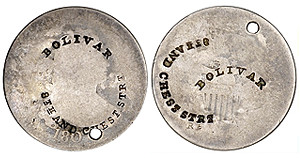
We present a magnificent collection of counterstamped coins. This has been gathered over a long period of years by Anthony Terranova one of America's leading professional numismatists, a consummate connoisseur who has been a friend of Stack's for a long time.
These mainly consist of the advertising imprints of American merchants stamped on circulating coins of the realm—which in 19th-century America included federal issues, Spanish-American silver, and other issues. It was not until two and one-half years after the Act of February 21, 1857, that certain foreign coins were no longer legal tender in the United States. It may come as a surprise to learn that in the early 1850s, Spanish-American silver two-reales coins, valued at about 25¢, were much more plentiful in circulation in America than were Liberty Seated quarters.
The imprinting of a message on a circulating coin furnished, in effect, a traveling billboard that passed from hand to hand in the channels of commerce. Thus, a hotel in Philadelphia or a broker in New York City could advertise free of charge. Each viewer became a potential customer, at least within the geographical range of the issuer.
The collecting of counterstamped coins furnishes the possibility of getting two specimens for the price of one! In each instance, a regularly struck coin or token, called the host coin, was selected for use. Given a preference, a counterstamper would choose a well-worn Spanish-American silver two-real piece or large copper cent to a coin with little evidence of circulation. The well-worn variety offered a better matrix or canvas, so to speak, for all of the counterstamped letters to be delineated sharply and properly.
To read the complete article, see: The Anthony Terranova Collection of Counterstamped Coins (stacks.com/Auction/Collection/89)
Lot 5013
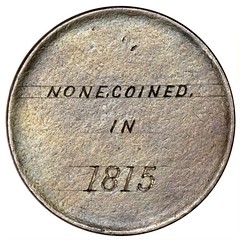 Large cent. Blank planchet with upset rim. NONE COINED / IN / 1815 engraved on one side, uniface.
Large cent. Blank planchet with upset rim. NONE COINED / IN / 1815 engraved on one side, uniface.
Deep golden brown. Perhaps this was a custom-made filler in a large cent collection from a bygone era, quite possibly the late 1850s when numismatists were not quite certain whether any were coined in this year.
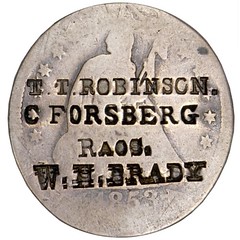 Lot 5054
Quarter. 1853 Arrows and Rays. Brunk unlisted. T.T. ROBINSON. / C. FORSBERG / RAGS / W.H. BRADY on four on obverse of host. Host coin Fair-2.
Lot 5054
Quarter. 1853 Arrows and Rays. Brunk unlisted. T.T. ROBINSON. / C. FORSBERG / RAGS / W.H. BRADY on four on obverse of host. Host coin Fair-2.
Deep golden gray with lighter golden highlights and a forcefully impressed counterstamp. While the T.T. ROBINSON and the W.H. BRADY counterstamps are unlisted in the Brunk reference, the C. FORSBERG counterstamp is listed as Brunk F-344.
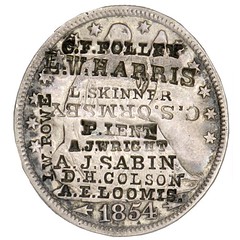 Lot 5140
Half dollar. 1854 Arrows. Host coin with merchant's names impressed, 10 on the obverse and five on the reverse. Host coin EF or so.
Lot 5140
Half dollar. 1854 Arrows. Host coin with merchant's names impressed, 10 on the obverse and five on the reverse. Host coin EF or so.
Medium golden gray centers with rich rose, navy, and deepening gold, especially toward the rims. The impressions include. Obverse: G.F. POLLEY / L.W. HARRIS / L. SKINNER (Brunk S-492) / C.S. ORMSBY / P. LENT / A.S. WRIGHT / A.J. SABIN / D.H. COLSON / A.E. LOOMIS (Brunk L-482) / I.W. ROWE. Reverse: C.B. HOYT / A.N.W. & Co / EATON NY/ L.C. TABER / N. DEAN. An interesting issue.
 Lot 5168
Half dollar. 1895. Brunk not found. BOB DALTON OUTLAW on obverse of host. Host coin AG-3.
Lot 5168
Half dollar. 1895. Brunk not found. BOB DALTON OUTLAW on obverse of host. Host coin AG-3.
Medium golden gray with steel highlights. BOB DALTON / OUTLAW / KILLED AT COFFEYVILLE / KAN. / OCT. 5. / '95 on six lines at obverse center.
Early on the morning of October 5th, 1892, five members of the infamous Dalton Gang—Grat, Emmett, and Bob Dalton, along with Bill Power and Dick Broadwell—rode into Coffeyville, Kansas with robbery on their minds. Their plan was to hold up both town banks simultaneously. The Daltons were familiar with the town, having grown up nearby. However, they were also familiar faces around town; the gang employed disguises, but to no avail. After a mix-up in their plans—they had to tie their horses in an alley as the hitching posts in front of the banks were removed for repair—the robbers split up and entered the banks only to hear someone on the street yell "the bank is being robbed." This call was repeated up and down the street and a dozen or more armed locals organized town-wide resistance. The ensuing gun battle lasted less than 15 minutes; the end result was four dead locals and four dead gang members, including Grat and Bob Dalton along with Broadwell and Power.
THE BOOK BAZARRE
MORE ON UNIVERSITY DEGREES IN NUMISMATICS
Ray Flanigan writes:
Don Kagin's degree is a PhD - he got several professors to work with him and did his dissertation on California Gold - basically it was his book or his book was his dissertation.
Jonathan Kern's degree is a BS in Numismatics but basically it's in Metallurgy. He was in school, left and returned - slightly older than other students and allowed to do a lot of independent work.
Numismatics is a more accepted discipline in Europe - it should be here, too. Several colleges offer courses - no one a degree (except under special conditions like Don and Jon). Ted Buttrey has taught at Michigan, Alan Stahl now at Princeton came from the ANS and taught a semester at Notre Dame.
Princeton, Notre Dame, Cornell, Bowdoin and Harvard all have significant collections - about 10 other have some very good collections - so courses should be possible.
Don Kagin writes:
I believe Jon Kern's bachelors degree in numismatics emphasized metallurgy and mine was more historically oriented, taking courses in the College of Arts and Sciences which included independent studies from the Greek and Roman Department (Ancients), Probability and Statistics (Math Department), and various Political and History Department courses. I believe three of these papers were eventually published in The Numismatist and I would be happy to send copies to anyone interested in them.
I believe Stanley Appelbaum of First Coin Investors (I may have the wrong spelling) and later Pine Tree Auction Company located in Rockville Center, N.Y. was the visionary behind the Adelphi program, but I don't remember they awarding a formal degree.
To read the complete article, see: ON UNIVERSITY DEGREES IN NUMISMATICS (www.coinbooks.org/esylum_v13n38a17.html)
NOTES FROM E-SYLUM READERS: SEPTEMBER 26, 2010
Ray Williams writes:
Thanks to Tom, Charlie, John and Richard for replying to my inquiry about the 1925 Guttag publication. I do vaguely remember seeing a Guttag at John's house, but just assumed it was the same issue as mine. I have three 1927 issues (actually two, because I gave one away last weekend). I'll keep an eye out for a 1925.
Bruce Lorich writes:
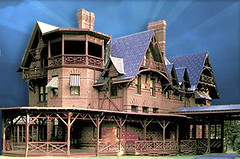 I have a tidbit to add to the article on Lost Libraries. On the way to the ANA convention in Boston in August, I stopped in Hartford, CT, to see the Mark Twain House. My wife and youngest son and I spent about five hours on two tours of the house.
I have a tidbit to add to the article on Lost Libraries. On the way to the ANA convention in Boston in August, I stopped in Hartford, CT, to see the Mark Twain House. My wife and youngest son and I spent about five hours on two tours of the house.
My addition to that fine article is this: Mark Twain invested in a typesetting machine, put most of his fortune (made from his writing) into it, and it nearly sank him. It was a brilliant idea for a man who once had earned his living setting type by hand, but a competing invention called the Linotype Machine came into existence at almost the same moment as the machine Twain backed, and it was far superior. The only surviving example of Twain's monstrous machine can be seen at his house in Hartford (the other was scrapped during WW2 for metal).
Twain was forced to sell his house, the one we toured, and all his furniture, including his library. He did not willingly give it up or donate his books. He was broke! This occurred about 1910, after the Twains had lived in the mansion for about 35 years. He took his wife and daughter to another house in upstate New York, given to them by his wife's father. Her family was wealthy, but their daughter's husband, whom she had met on a ship coming back from Europe when Twain was researching his book "The Innocents Abroad," was one of the most famous celebrities in late 19th-century America.
I recommend visiting his house, now almost fully restored, in Hartford.
For more information on the Mark Twain House, see: www.marktwainhouse.org
Relating to our recent items on Dickin medal winning animals, I came across a book offered on eBay that tells the story of one of the animals.
This book tells the story of Antis, an Alsatian dog who was awarded the Dickin Medal on January 28, 1949. The dog served with his Czech owner in the French Air Force and RAF from 1940 to 1945 in both North Africa and England.
To view the complete eBay lot description, see: One Man and His Dog ANTIS Dickin Medal winner WWII book (cgi.ebay.com/ws/eBayISAPI.dll?ViewItem&item=150495772969)
Regarding the Andy Warhol Indian Head Nickel artwork, Dave Lange writes:
Warhol must have used as his model one of the extremely rare patterns held by the Smithsonian, as his painting lacks the designer's initial, and the 3 has a round top. These features are common to the patterns.
To read the earlier E-Sylum article, see: ANDY WARHOL'S INDIAN HEAD NICKEL DISPLAYED AT WASHINGTON HOTEL (www.coinbooks.org/esylum_v13n38a20.html)
THE BOOK BAZARRE
INDIAN BANKNOTE COLLECTOR TO OPEN MUSEUM, PUBLISH BOOKS
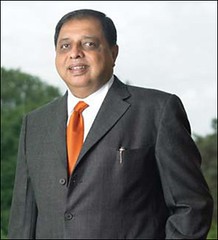 Most people know Rezwan Razack as a promoter of Prestige Constructions, a well-known real estate developer in south India.
Most people know Rezwan Razack as a promoter of Prestige Constructions, a well-known real estate developer in south India.
But there's something about Razack that few people know - he is India's biggest collector of banknotes, who claims to possess one, or more, of every variety of paper currency printed in India since 1770s, when private banks in India first began issuing banknotes.
And now Razack is ready to throw open his exhaustive collection to interested viewers. Later this year, he will open a museum housing his collection in a 4,000 sq ft space in Prestige Shantiniketan, a large mixed-use development in Bangalore's Whitfield area.
When it opens it will be the country's first museum of banknotes. (The RBI Monetary Museum and Dinesh Modi Numismatics Museum at the University of Mumbai's [ Images ] Kalina complex have banknotes, but they have coins as well.)
Razack, 55, says he has been collecting banknotes for the last 40-45 years, since he was a child.
"My family members were traders and we had a treasury in the house where they would keep money. Few people in those days went to banks for fear they would go bust. They'd give me bundles of banknotes and tell me to put it inside the treasury. Once I found a note with the inscriptions, 'Reserve Bank of India' [ Get Quote ] and 'Government of Pakistan', and 'payment refused' overwritten on it. I went and gave it to my elders who started complaining that they had been cheated."
Young Razack kept the note, not knowing that these were a historical oddity -some of the notes issued by RBI during the 10 months immediately after August 15, 1947 when it was also the currency-issuing agency for Pakistan.
Today, these notes sell for anywhere between Rs 10,000 and Rs 100,000, depending on denomination and condition, says Kishore Jhunjhunwala, a prominent collector of banknotes and author of Standard Reference Guide to Indian Paper Money.
Over the years, Razack continued to collect banknotes - at first smuggling out one or two unusual specimens from the wads his uncles gave him. As his collection grew, he began visiting cut-note dealers and later, stamp dealers and auctions in India and across the globe. Since 1998, he has also been buying online, via eBay.
It wasn't easy, he says. For one, there was very little information on the kinds of banknotes, the watermarks, printing and other finer details. And two, unlike coins, old paper money was hard to come by. "Culturally, Indians don't get paper money.
Many people have old coins, but seldom banknotes. It was only when someone put them away and forgot all about it for so long that they were demonetised, that they got preserved.
Besides the museum, Razack is also ready with two books, which too will come out later this year, he says, "The first, a coffee-tabler called For the Love of Money, will highlight unique banknotes such as the fractions - two-and-a-half rupees, and other, the 'stars' that did not make it."
The other will be a pictorial catalogue of the history of Indian banknotes giving all details of watermarks, printers, signatures, issuing banks, circulation dates - a kind of reference guide to collectors.
To read the complete article, see:
Meet India's biggest collector of banknotes
(business.rediff.com/special/2010/sep/23/spec-meet-indias
-biggest-collector-of-banknotes.htm)
WILL RUSSIA ABOLISH ONE AND FIVE KOPEK COINS?
Twenty months ago I wrote of the Russian coin situation where the chief banker recommended that the two lowest coin denominations be abolished. This was in The E-Sylum volume 12, number 1, article 22.
Of course no action was taken to stop making these two low denomination coins. Now the problem is even worse. If we can believe an article published this week, it costs 45 times the face value of the lowly kopek to make and place the coin in circulation. It is even worse for the 5-kopek coin -- 69 times face value!
A ruble is 32 cents U.S. You can imagine the purchasing power of a coin one-one hundredth of that!
The Durma is the central committee to make the decision whether or not to eliminate the two coins. One Durma member stated “Even in the villages, where there are no roads, they use kopecks to make the floors.” I assume that was a literal translation. Perhaps the villagers are lining their floors with one kopek coins.
To read the article from the Financial Times check on: Russia's kopeck coin(s) (0.3 and 1.5 cent) may soon be scrap metal (freerepublic.com/focus/f-news/2596127/posts)
To read the earlier E-Sylum article, see: RUSSIAN BANKER RECOMMENDS DROPPING TWO SMALLEST COINS (www.coinbooks.org/esylum_v12n01a22.html)
ALTERNATE USE FOR SILVER COINS: KILLING BACTERIA
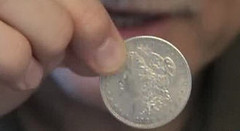 Researchers at Stanford have developed a new kind of filter, a cheap and fast way to purify water in poor parts of the world and on camping trips.
Researchers at Stanford have developed a new kind of filter, a cheap and fast way to purify water in poor parts of the world and on camping trips.
In her Stanford laboratory, Alia Schoen purifies water using a new method thousands of times faster than anything previous. It uses nanotechnology and silver.
In the days before milk could be pasteurized or refrigerated, people would drop a silver coin into a bottle to preserve it. Silver is lethal to bacteria. Tiny amounts of silver are already woven into antibacterial socks, underwear and band-aids. You could build water filters out of silver, but the metal is so costly, it would kill your bank account before it killed the bacteria.
Now, nanotechnology is changing that.
It turns out that if you run a minute amount of electricity through microscopic silver, it amplifies its antibacterial powers by thousands of times.
"What we thought was a crazy idea at the time, to combine electricity with nanowires to treat water."
The crazy combination of nanosilver and nanocarbon did the trick. It enables them to filter 98 percent of the E. coli in a water sample in one pass using so little electricity, it can run on 9-volt batteries. Professor Cui, of Stanford's Materials Science department says, "We use a tiny amount. So, it is possible to scale this filter up to a very large size. There's no reason we cannot do thousands of gallons quickly."
To read the complete article, see: Stanford researchers purifying water with silver (abclocal.go.com/kgo/story?section=news/drive_to_discover&id=7677070)
WEEKLY WORLD NEWS BREAKS STORY: OBAMA ON NEW DOLLAR BILL
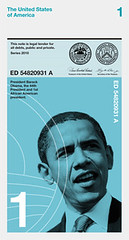 The White House has approved the redesign of U.S. currency. Barack Obama will be on the new dollar bill.
The White House has approved the redesign of U.S. currency. Barack Obama will be on the new dollar bill.
The Obama Administration feels that the American dollar is in bad need of a makeover. They have partnered with the Dollar ReDe$ign Project to pick a new design for U.S. currency. Currently, the design that the administration likes best was done by Dowling Duncan (a British duo), which features a unique vertical design. It also features President Obama on the one dollar bill.
“We love the Dowling Duncan look. They've come up with a creative design and put President Obama where he belongs… on number 1,” said David Axelrod, Senior Adviser to President Obama.
“Don't waste your time submitting a design, it's a done deal,” said Rahm Emanuel, White House Chief of Staff. The President wants “change” in the currency and we've unanimously picked Dowling Duncan's work. Fed Chairman, Benjamin Bernanke, has signed off on our choice for the redesign. We intend to have the money in circulation by June, 2011.”
Emanuel went on to say that there are plans to redo U.S. coins as well. “We don't need a complete redesign of our coins, but we do want to put President Obama on the penny and move President Lincoln to the nickel. Thomas Jefferson, who was on the nickel, will be… discontinued.” Republican Congressman Paul Ryan suggested President Obama be put on both the “nickel and dime” instead of the penny.
Another American icon might also be replaced. “Uncle Sam is outdated,” said Axelrod. “We need to update this icon as well. It will now be Uncle Barack.”
Republicans are apoplectic about the changes the Administration is proposing. “They won't get this passed when we get control of the house,” said Minority Leader John Boehner. “Typical Republicans, they want to block everything, even a little meaningless design issue,” said Speaker of the House Nancy Pelosi. “It doesn't matter what they think, we're going to pass this and every American will be carrying Obama dollars in their wallets and purses come June.”
FYI: The Obama dollar will reportedly be worth $0.47.
To read the complete article, see: OBAMA ON NEW DOLLAR BILL (weeklyworldnews.com/politics/22345/obama-on-new-dollar-bill/)
"It is the opinion of this court that the right to speak without censorship or fear of intimidation is fundamental to a healthy democracy," Justice Ruth Bader Ginsburg wrote for the majority. "Furthermore, the court finds that the right to say whatever the hell you want, whenever the hell you want, is not only a founding tenet, but remains essential to the continued success of this nation."
FEATURED WEB SITE: PORTABLE ANTIQUITIES SCHEME DATABASE
This week's Featured Web Page is the Portable Antiquities Scheme database, suggested by Kavan Ratnatunga. Thanks! He writes:
Thanks for posting information about my hoard. Looking for images of other coins with that counter mark I stumbled upon the Portable Antiquities Scheme database.
There are over 200,000 entries for coins with images. I even found one I was looking for.

The Portable Antiquities Scheme is a voluntary scheme to record archaeological objects found by members of the public in England and Wales. Every year many thousands of objects are discovered, many of these by metal-detector users, but also by people whilst out walking, gardening or going about their daily work. Such discoveries offer an important source for understanding our past.
This website provides background information on the Portable Antiquities Scheme, news articles, events listings and access to our database of objects and images.
www.finds.org.uk
